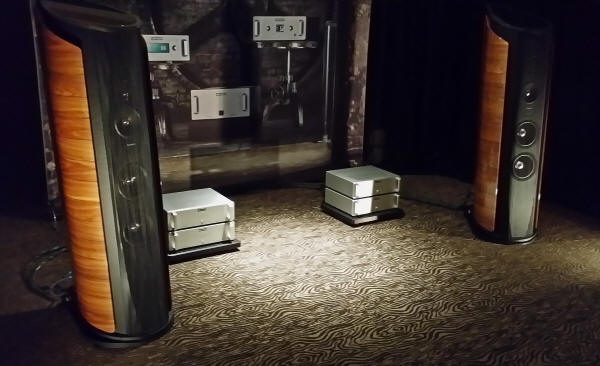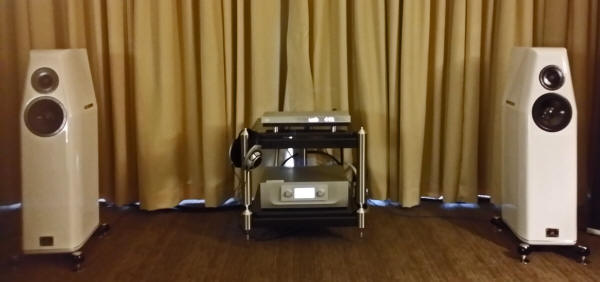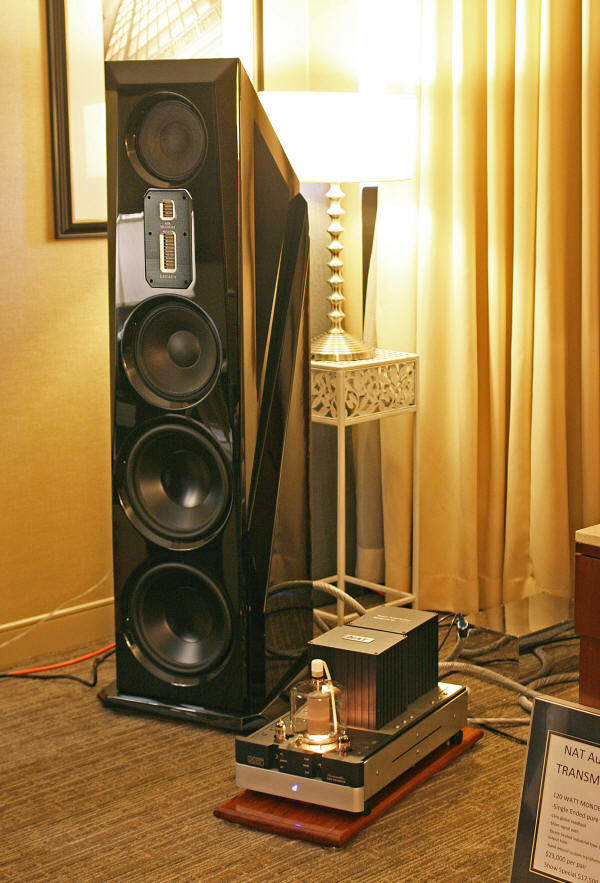You are reading the older HTML site
Positive Feedback ISSUE 73
My Top Three Rooms - 2014 Axpona Chicago
High End Show
[All photographs by Robert S. Youman] To my eyes and ears, Axpona 2014 was a huge success. Attendance was plentiful. Spirits were high for both exhibitors and attendees. It was a lovely crisp cool weekend in Chicago. Food and entertainment choices were superb! Smiles and laughs were everywhere! What's not to love? Like last year, I will continue with the same format as I received some excellent feedback from readers for that choice. Instead of an overall show report, I have selected my three favorite rooms for sound, and will report on what I experienced in more detail.
Quintessence Audio - Sonus Faber, Audio Research, Harmonic Resolution Systems, Kubala Sosna Quintessence Audio is a fixture in the Chicago audiophile community. After 30 years, many would argue that Quintessence is one of the last bastions of high-end retail stability in the entire Midwest. They survive on more than just great product lines and responsive customer service and satisfaction. Mick Survance (Quintessence) and Allan Haggar (Sumiko/Sonus Faber) know how to put on a good show. They understand what makes a difference and what their customers really want/demand! This was my first experience with the flagship Sonus Faber Aida Speakers ($120K). As always for Sonus Faber, the overall aesthetic design is startling. I thought the Sonus Faber Futura (see my earlier Positive Feedback review in Issue 61 was a visual delight, but the Aida is something else. The cabinet just might be the sexiest ever from this highly creative company. At 365 pounds of muscle and curves, we have something different this time around with both front and rear drivers. There is also a series of controls to fine tune the midrange and tweeter settings. As we all know, most show listening rooms are a disaster. In this case, all the floor to ceiling drapes and acoustic treatments that big budgets can afford were not gonna help. But, put a couple of great ears like Mick and Allen on the same challenge, and presto we have some excellent sound. My guess is that the flexibility and adjustable settings on the Aida had much to do with this too. A full Harmonic Resolution SXT rack of all Audio Research components might have also contributed. This included the Reference CD9 CD Player/DAC ($13K), Reference 5SE Line Stage ($13K), Reference 2SE Phone Stage ($13K), and the DS540M Amplifiers ($24K). Yes, bass performance was not as good as we might like; just a little too overpowering and loose on a few of the rock and house music recordings. How much control can you dial in with drapes and no walls? But...the mids and highs were as sweet and delicious as you could want. From a front center seat, I could hear way back into the soundstage and imaging was absolutely remarkable—rare stuff at a show setting. A high resolution recording of Muddy Waters Folk Singer made an immediate impression. On "Good Morning Little School Girl," I could hear Muddy's voice echo throughout the Chess Records recording studio (located in Chicago back in the day). Kinda makes your hair stand on end when reproduced properly. Buddy Guy was something like seventeen years old on this recording. Standing just outside the right speaker, when his simple guitar licks kick in, you might as well walk over and shake his hand. Just the right amount of twang, harmonics, and titillation (sorry—not an inappropriate description of the music in this case). I'd love to get these into my listening room for a fairer appraisal. Gosh, a Magico Q7 and Sonus Faber Aida bare knuckles fist fight would be awesome stuff!
Musical Artisans - Constellation Audio, Kharma, Resolution Audio, Argento Audio I love simplicity. I hate clutter. Give me a synergistic system with an integrated amp, a pair of speakers and one high quality source (analog or digital) and I am one happy camper. Some audiophiles may take a condescending attitude towards such simplicity, but it's hard to beat the value, level of performance and the variety of options out there these days. Ricardo Reyes (Musical Artisans) is another one of those few remaining distributors/dealers who can really be trusted for their experience and insight. Another Chicago guy, he goes way back with some of the most elite and engaging product lines in the industry. Irv Gross, who has provided executive marketing and sales leadership for such premier brands as Krell, Magico, and Constellation is another "veteran of the wars" who can really talk the talk and walk the walk. Like the Quintessence Room, we have here another wonderful meeting of the minds and the results were very clear. Kharma speakers are back and in full force! The sound emanating from the Kharma S7 Elegance Speakers ($17.4K) in a chic white finish combined with the new Constellation Argo Integrated Amp ($22.5K) and Resolution Audio Contata Music Center DAC ($6.5K) was an absolute stunner. I have not experienced the "Kharma Sound" in several years, but something seemed different about the Elegance S7 Speakers. Detail and speed were all there as before, but I sensed a certain level of warmth and roundness that was new to my ears and quite appealing. Could it be the Argo or the Cantata or the Argento Flow wire throughout was the major contributor? Probably some combination of all of the above. Regardless, the sound was just stellar! It might just have been a coincidence, but it seemed like many rooms were playing tributes to Chicago artists and especially the blues. A much older Buddy Guy was now playing in the room and standing just a few feet away. His Blues Singer album touched all the right bases for me. This man can really wail on guitar and over the years his voice has become much more mature and expressive. Again, this system provided impressive levels of resolution, dynamics, and just overall seduction! It was hard to sit still—my toes were a-tappin' big time!
Midwest Audio – Legacy, NAT, Triangle, Resonessence Labs My favorite room was not really a surprise, but more of a revelation. I have heard several Legacy speakers over the years at both shows and in private listening rooms. Having lived in Chicago for most of my adult life, I always had a hankering to take a road trip down to Springfield, Illinois, where Legacy headquarters is located. Many friends tell me that their listening rooms are unrivaled and their generous hospitality alone is well worth the trip. One memory that always seems to resonate is that Legacy speakers can really move some air. The original Legacy Focus came out in the early 1990s. I had a friend who had a pair, and whenever we put on some Who, or Stones or Pink Floyd, we were in Rock ‘n Roll heaven. Beyond that, the Legacy Focus speakers provided a very sophisticated sound that could play any genre of music with great results. Definitely a big bang-for-the-buck, even back then! The Legacy Aeris Speakers are cut from the same cloth but are even more refined and articulate. At $20,735 (with Black pearl finish), they are without question one of the great values in high-end audio. Yes, that is still a significant amount of money, but these days when all the audiophile magazines are reviewing many speakers in the $50K to $200K range, the Aeris stands tall and strong. I am told that there are three keys to this superb design and execution. Bill Dudleston (Legacy CEO and Chief Designer) continues to demonstrate his innovative track record by not being afraid to think out of the box. 1.) A multi-functional 40-bit matrix DSP room correction processor is utilized between the preamp and amplifier. 2.) Each speaker cabinet has two 12 inch woofers, each woofer driven by its own dedicated 500 watt ICE Class D amplifier (yes, we are talking four amplifiers for the four woofers). 3.) Highs are provided by well integrated Heil AMT tweeters—still one of the best if properly implemented. This woofer and dedicated amp design allows you some flexibility in amplifier selection for the midrange and tweeter drivers. The all tube NAT Audio Transmitter Amps ($23K), Symmetrical Preamp ($10K), and Signature Phono Amp ($10K) seemed to be adding a great deal of addictive bloom and inner detail to the sound—but I could not verify this without a comparison to other electronics. I'd also love to get my hands on the Resonessence Invicta Mirus DSD DAC ($5K) that was one of several front ends for the system. For most of my time in the room, there was plenty of modern well recorded "world music" type tracks playing. These tend to be impressive even on the most average systems: Plenty of deep tight bass and spectacular acoustic and electric instruments entering and exiting the sound stage. The Aeris performed well beyond the call of duty, but I wanted more. Then the magic stepped forward. I asked for a little acoustic jazz with some male or female vocals. "The Girl From Ipanena" written by Antonio Carlos Jobim and sung by Astrud Gilberto with Stan Getz on sax is a great test—not bad for a 60-year-old recording (1962). I have never heard it better. Vocals were pure and creamy. Piano had plenty of resonance and texture. Even Getz on sax had just the right amount of sizzle and leading edge. This is not always the case with other expensive systems. It can be an impressive track, but that sax can also burn your ears off in the wrong hands. Bottom line: There was a combination of transparency and speed along with a natural weight and timbre that was hard to believe at this price point. Definitely worth a listen if not a road trip! Final Comments I must say a few words about Michael Fremer of Stereophile and Analog Planet. Somehow I always manage to run into him at the high-end Shows. I am fairly certain that he has no clue who I am, but he always extends a polite hand and has a warm cordial smile for me. On very rare occasions, I send him an email with a few questions. He always responds. Usually his response is short and quick—but to the point and helpful. The poor guy can rarely walk down the hallway without someone stopping him or shouting a few comments—both respectful and disrespectful, unfortunately. He always seems to have a positive attitude regardless. I love reading his columns and watching him in action at his seminars (including those at this year's Axpona). He can be direct, and sometimes even confrontational, but he always speaks the truth! We need that. I for one am very pleased that he is one of our industry leaders and carries the torch for all of us! Hey Michael—great job at Axpona!
|




